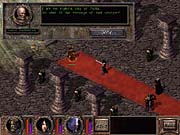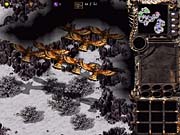The real-time strategy genre is highly competitive - such games must do a lot to distinguish themselves from one another to succeed. However, Kingdom Under Fire by Korean developer Phantagram doesn't do much to distinguish itself, except in that all the units in the game earn experience levels and get more powerful as they win battles. Drawing a comparison between Kingdom Under Fire and many other similar games isn't hard to do. In fact, Kingdom Under Fire seems like the result of what would happen if every game released by Blizzard Entertainment in the last five years were blended together. It has many similarities to Blizzard's real-time strategy games Warcraft II and Starcraft, as well as the action-packed role-playing game, Diablo - so much so that it's apparent the designers of Kingdom Under Fire played and enjoyed all these games. Kingdom Under Fire has its own interesting story, numerous units available for two different playable sides, and plenty of missions to keep you busy. But flaws in the computer's artificial intelligence, the lack of a convenient save feature, and an overall lack of originality all serve to drastically weaken the game.

Like Warcraft II, the more recent Warlords Battlecry, and countless other games, Kingdom Under Fire is mostly a conventional 2D fantasy-themed real-time strategy game. You'll have to gather different resources and build structures with your workers, train an army of mixed forces, research some upgrades, and then attack and destroy your enemies. The game takes place in a fantasy kingdom called Bersiah, where a great war was fought between the forces of light and dark a hundred years ago. The legendary Knights of Xok defeated the evil, and Bersiah was restored to peace and prosperity. But now, another war is brewing in Bersiah: Orcs are attacking settlements, and humans are in a conflict over who will take the throne of the most powerful nation, Azillia. Meanwhile, a being named Rick Blood unites the forces of darkness into the Dark Legion and begins a full invasion of the land.
The 2D graphics in the game are done fairly well, although they aren't outstanding. Kingdom Under Fire's gigantic flying units are rather impressive, especially the dragons. Though the unit animations are only mediocre, the shadows that the units cast are pretty convincing, and some of the special effects are good. Otherwise, the human structures are bland, and distinguishing them from one another can be confusing, though the Dark Legion buildings tend to be more interesting. The sounds in the game aren't that great, either. Some of the voices are done well, but most are disappointing or even embarrassing. When you click on the units or give them an order, most of them have repetitive acknowledgement remarks. The music is the only redeeming aspect to the game's sound: It is a well-done score, complete with vocals, and it fits the atmosphere of the game for both sides.

Kingdom Under Fire does a good job of telling the story from each side in between each mission - it uses first-person narration by some of the game's main characters. You can play as both sides: the forces of light, which include humans, dwarves, and elves; or the forces of dark, which consist of orcs, ogres, undead, and other creatures. The two forces have different types of units, although their functions are relatively equal. Both sides have a basic grunt, ranged, flying, and spellcasting units. There are also powerful hero characters on each side. Most of these heroes are crucial to the mission, so if they die, you have to start over.
All units in the game gain experience for killing other units or buildings (including their own!) or by healing friendly units. With every level they gain, they become stronger and more proficient in combat. Higher-level units can be distinguished from lower-level units by the different colored circles that appear when they're selected. Unfortunately, combat can be devastating to these and all your forces, since units die relatively quickly and easily, regardless of their level. A hero unit can usually dispatch wave after wave of basic infantry, which is why heroes are vital to your army, especially since their experience earned in previous missions carries over to the next ones. So while it's possible to win missions by wearing down enemy heroes with countless troops, you'll probably end up using your heroes to do most of the damage; of course, risking your heroes can be dangerous since you can't let them die, especially since the game doesn't let you save your progress during a mission. Spending a couple of hours pressing into an enemy base, only to have your hero die, can be a serious letdown. Because the missions in Kingdom Under Fire can be so unforgiving, it's most suitable for veterans of similar real-time strategy games.
Both campaigns have 13 missions each: ten real-time strategy and three role-playing, in which you control a hero character through a dungeon crawl, much like in Blizzard's Diablo games. The two different campaigns take place during the same time period, and this is reflected in the missions. For example, the first human mission takes place in exactly the same location as the first Dark Legion mission - the only difference is the perspective. While not every mission is the same on both sides, they do tie together in the end.
The role-playing missions can help your hero improve his chances of survival. Not only do they help raise the hero's levels, but they also give your hero a chance to equip himself with better items for improving his stats. However, if it weren't for the incentive in finding these items, you'd most likely try to complete these role-playing missions as quickly as possible, because they simply aren't very fun. The small, isometric 2D graphics and the mouse-driven controls are very similar to those in Blizzard's Diablo games, but their implementation in Kingdom Under Fire is rather mundane compared with Diablo. Unlike in the strategy missions, the view in the role-playing missions is locked on the character so that you can't scroll the screen to help find areas you missed. Some missions give you more than one hero to work with, so when both are selected, one of them may be off the screen. This can prove deadly, because if you aren't watching the other character's health, he may die without your even noticing.
Throughout the game, the computer opponent's artificial intelligence is nothing spectacular, and it can easily be anticipated. During the strategy missions, the computer will randomly send out strikes against your base, but due to the defensive nature of most maps, it's easy to set up ambushes at choke points. The computer is less predictable with its use of flying units, which can attack from any direction. Unfortunately, you'll quickly discover that the unit pathfinding is terrible. Your units will not move out of the way for each other, which will lead to clogged pathways and frustrating battles. Navigating the maps is even worse because half of a group will often get stuck in turns, due to the twisting layout. This can be devastating when you're depending on a group of archers for reinforcements, or even worse when an enemy patrol picks off the stragglers when you're not looking. Although a patch is available that allegedly addresses problems with both the computer AI and the pathfinding, the patch makes only marginal improvements.
The game's other problems are mostly a direct consequence of its focus on powerful hero characters. Later in the campaigns, ground troops become almost worthless because a single hero with a group of healers and ranged units for backup will be able to demolish almost any enemy encampment in its way. Because of this, there really isn't much use for resources later on in a match, though early on, you'll them to build up a base and defenses. But later, you could just use your money to train up a bunch of weak warriors and have your heroes kill them off to gain more experience.
In addition to the lack of a save feature during missions, what makes the game so long and frustrating to play is the sheer amount of micromanagement that it demands from you. Idle workers can be hard to find since they blend in with the buildings. You can place only 20 units in a group, which won't last long by itself. Troops also like to wander off from each other. You can order them to hold position, but this causes some of them to simply not do anything. Target acquisition is pretty slow as well, which makes the gameplay seem sluggish. Unit formations don't work correctly, either. Every group can have an assigned leader, who then has an option to set group formations. However, when you try to move the group, it will remain scattered.
The game does offer a skirmish mode and multiplayer capabilities, and both skirmish and multiplayer strategies are very different from the campaigns. Since you have no heroes when you start in these modes, you'll actually have to rely on your basic units. Unfortunately, in a skirmish, the computer opponents tend to team up against you, which diminishes your chances of success. If computer opponents prove too tough or too predictable, you can also log onto Phantagram's Wargate service to find other players to play against.
A few years ago, Kingdom Under Fire may have been less disappointing - but since so many innovative and impressive real-time strategy games were released in the last year, it will probably be very tedious for anyone who doesn't still prefer older games in the genre. Die-hard real-time strategy fans may find something to like in Kingdom Under Fire, but everyone else might as well keep waiting for Blizzard's next big hit.